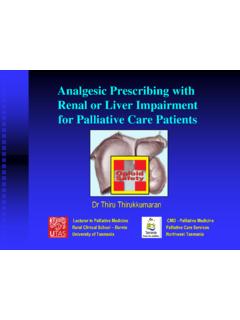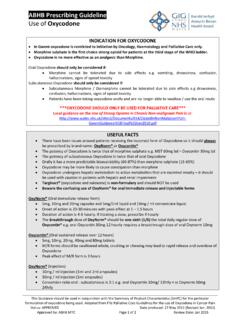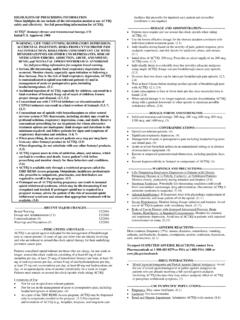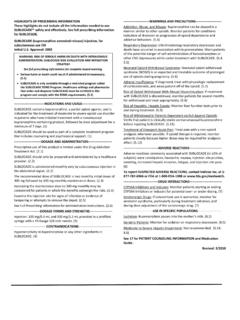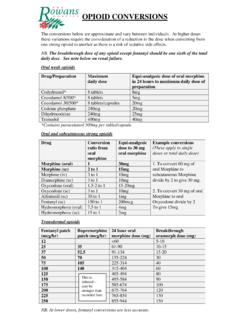Transcription of NEW ZEALAND DATA SHEET - Medsafe
1 NEW ZEALAND data SHEET Page 1 of 11 1 PRODUCT NAME TEMGESIC INJECTION 300 micrograms/mL solution for injection 2 QUALITATIVE AND QUANTITATIVE COMPOSITION Buprenorphine (as hydrochloride) 300 micrograms/mL Excipients with known effect: 55 mg glucose monohydrate. For full list of excipients, see 3 PHARMACEUTICAL FORM Solution for injection. Colourless liquid. 4 CLINICAL PARTICULARS The rape utic indications Strong analgesic for the relief of moderate to severe pain, including post-operative and terminal pain. It is not recommended for use in children.
2 TEMGESIC does not have an approved role in opioid dependence rehabilitation programs. Dos e and me thod of adminis tration The ampoule should be inspected visually for particulate matter and discolouration prior to administration. The recommended dosage is 300 - 600 micrograms by intramuscular or slow intravenous injection, repeated every 6 - 8 hours, or as required. Temgesic Injection may be employed in balanced anaesthetic techniques as a pre-medication at a dose of 300 micrograms , or as an analgesic supplement at doses of 300 to 450 micrograms Contraindications Pregnancy and Lactation (see section ).
3 TEMGESIC should not be administered to patients who have been shown to be hypersensitive to buprenorphine or other opioids. Hypersensitivity to any of the ingredients. Spe cial warnings and pre cautions for us e Naloxone may not be effective in reversing the respiratory depression produced by TEMGESIC. Therefore, the primary management of overdose should be the re-establishment of adequate ventilation with mechanical assistance of respiration, if required. General TEMGESIC should be administered with caution in debilitated patients and those with myxoedema or hypothyroidism, adrenal cortical insufficiency ( Addison s disease), toxic psychoses, orthostatic NEW ZEALAND data SHEET Page 2 of 11 hypotension, prostatic hypertrophy or urethral stricture, acute alcoholism, delirium tremens or kyphoscoliosis.
4 Psychological dependence (addiction), abuse, misuse and diversion Controlled human and animal studies indicate that buprenorphine has a lower dependence liability than pure agonist analgesics. In humans, limited euphorigenic effects have been observed with buprenorphine. However, as with other opioids, there is a potential for abuse of the medicine and for development of strong psychological dependence. Although the risk of addiction in any individua l is unknown, it may occur in patients appropriately prescribed TEMGESIC and in those who obtain the medicine illicitly.
5 Psychological and/or physica l dependence may occur at recommended doses and if the medicine is misused or abused. Assess each patient s risk for addiction to opioids, abuse, or misuse prior to prescribing TEMGESIC and monitor all patients receiving TEMGESIC for the development of these behaviours or conditions. Risks are increased in patients with a personal or family history of substance abuse (including drug or alcohol abuse or addiction) or mental illness ( major depression). The potential for these risks should not, however, prevent the proper management of pain in any give n patient.
6 Patients at an increased risk may be prescribed opioids, but use in such patients necessitates comprehensive counselling about the risks and proper use of opioids, along with close monitoring for signs of addiction, abuse or misuse. TEMGESIC, like other opioids, can be diverted for non-medical use into illicit channels of distribution. TEMGESIC should therefore be prescribed and handled with a high degree of caution appropriate to the use of a medicine with strong abuse potential. Abuse of opioids poses a risk of overdose and death.
7 This risk is increased with concurrent abuse of opioids with alcohol and other substances including other opioids and benzodiazepines. Use in Opioid Dependent Patients Because of the narcotic antagonist activity of buprenorphine, use in individuals dependent on other opioids may result in withdrawal effects. The current opioid dependence level of patients with a history of opioid abuse or misuse should be assessed prior to treatment with analgesic buprenorphine products. Elderly The safety and efficacy of buprenorphine in elderly patients over 65 years have not been established.
8 Cardiovascular Effects Buprenorphine may cause a slight reduction in pulse rate and blood pressure in some patients. Like other opioids, buprenorphine may produce orthostatic hypotension in ambulatory patients. Respiratory Depression TEMGESIC occasionally causes significant respiratory depression and, as with other strong centrally acting analgesics, care should be taken when treating patients with impaired respiratory function (eg chronic obstructive pulmonary disease, asthma, cor pulmonale, decreased respiratory reserve, hypoxia , hypercapnia, or pre-existing respiratory depression) or patients who are receiving medicines which can cause CNS and/or respiratory depression.
9 Should respiratory depression occur to a clinically undesirable degree, supportive measures should be used to maintain adequate ventilation and oxygenation. The effects of buprenorphine are only partially reversed by standard narcotic reversal agents, such as naloxone. Patients with the physical and/or pharmacological risk factors above should be monitored, and dose reduction may be considered. Profound sedation, respiratory depression, coma, and death may result from the concomitant use of TEMGESIC with benzodiazepines or other CNS depressants ( , non-benzodiazepine sedatives/hypnotics, anxiolytics, tranquilizers, muscle relaxants, general anaesthetics, medicines with antihistamine-sedating actions such as antipsychotics, other opioids, alcohol).
10 Because of these risks, NEW ZEALAND data SHEET Page 3 of 11 reserve concomitant prescribing of these drugs for use in patients for whom alternative treatment options are inadequate. Observational studies have demonstrated that concomitant use of opioid analgesics and benzodiazepines increases the risk of medicine-related mortality compared to use of opioid analgesics alone. Because of similar pharmacological properties, it is reasonable to expect similar risk with the concomitant use of other CNS depressant drugs with opioid analgesics (see Section Interactions with other medicines and other forms of interaction).










